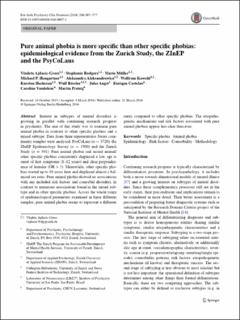Please use this identifier to cite or link to this item:
https://doi.org/10.21256/zhaw-2276| Publication type: | Article in scientific journal |
| Type of review: | Peer review (publication) |
| Title: | Pure animal phobia is more specific than other specific phobias : epidemiological evidence from the Zurich Study, the ZInEP and the PsyCoLaus |
| Authors: | Ajdacic-Gross, Vladeta Rodgers, Stephanie Müller, Mario Hengartner, Michael Pascal Aleksandrowicz, Aleksandra Kawohl, Wolfram Heekeren, Karsten Rössler, Wulf Angst, Jules Castelao, Enrique Vandeleur, Caroline Preisig, Martin |
| DOI: | 10.1007/s00406-016-0687-4 10.21256/zhaw-2276 |
| Published in: | European Archives of Psychiatry and Clinical Neuroscience |
| Volume(Issue): | 266 |
| Issue: | 6 |
| Page(s): | 567 |
| Pages to: | 577 |
| Issue Date: | Sep-2016 |
| Publisher / Ed. Institution: | Springer |
| ISSN: | 0940-1334 1433-8491 |
| Language: | English |
| Subjects: | Specific phobia; Animal phobia; Epidemiology; Risk factors; Comorbidity; Methodology |
| Subject (DDC): | 616.8: Neurology, diseases of nervous system |
| Abstract: | Interest in subtypes of mental disorders is growing in parallel with continuing research progress in psychiatry. The aim of this study was to examine pure animal phobia in contrast to other specific phobias and a mixed subtype. Data from three representative Swiss community samples were analysed: PsyCoLaus (n= 3720), the ZInEP Epidemiology Survey (n = 1500) and the Zurich Study (n= 591). Pure animal phobia and mixed animal/other specific phobias consistently displayed a low age at onset of first symptoms (8-12 years) and clear preponderance of females (OR > 3). Meanwhile, other specific phobias started up to 10 years later and displayed almost a balanced sex ratio. Pure animal phobia showed no associations with any included risk factors and comorbid disorders, in contrast to numerous associations found in the mixed subtype and in other specific phobias. Across the whole range of epidemiological parameters examined in three different samples, pure animal phobia seems to represent a different entity compared to other specific phobias. The etiopathogenetic mechanisms and risk factors associated with pure animal phobias appear less clear than ever. |
| Further description: | Erworben im Rahmen der Schweizer Nationallizenzen (http://www.nationallizenzen.ch) |
| URI: | https://digitalcollection.zhaw.ch/handle/11475/2276 |
| Fulltext version: | Published version |
| License (according to publishing contract): | Licence according to publishing contract |
| Departement: | Applied Psychology |
| Organisational Unit: | Psychological Institute (PI) |
| Appears in collections: | Publikationen Angewandte Psychologie |
Files in This Item:
| File | Description | Size | Format | |
|---|---|---|---|---|
| 2016_AjdacicGross-etal_Pure-Animal-Phobia-Is-More-Specific.pdf | 507.27 kB | Adobe PDF |  View/Open |
Show full item record
Ajdacic-Gross, V., Rodgers, S., Müller, M., Hengartner, M. P., Aleksandrowicz, A., Kawohl, W., Heekeren, K., Rössler, W., Angst, J., Castelao, E., Vandeleur, C., & Preisig, M. (2016). Pure animal phobia is more specific than other specific phobias : epidemiological evidence from the Zurich Study, the ZInEP and the PsyCoLaus. European Archives of Psychiatry and Clinical Neuroscience, 266(6), 567–577. https://doi.org/10.1007/s00406-016-0687-4
Ajdacic-Gross, V. et al. (2016) ‘Pure animal phobia is more specific than other specific phobias : epidemiological evidence from the Zurich Study, the ZInEP and the PsyCoLaus’, European Archives of Psychiatry and Clinical Neuroscience, 266(6), pp. 567–577. Available at: https://doi.org/10.1007/s00406-016-0687-4.
V. Ajdacic-Gross et al., “Pure animal phobia is more specific than other specific phobias : epidemiological evidence from the Zurich Study, the ZInEP and the PsyCoLaus,” European Archives of Psychiatry and Clinical Neuroscience, vol. 266, no. 6, pp. 567–577, Sep. 2016, doi: 10.1007/s00406-016-0687-4.
AJDACIC-GROSS, Vladeta, Stephanie RODGERS, Mario MÜLLER, Michael Pascal HENGARTNER, Aleksandra ALEKSANDROWICZ, Wolfram KAWOHL, Karsten HEEKEREN, Wulf RÖSSLER, Jules ANGST, Enrique CASTELAO, Caroline VANDELEUR und Martin PREISIG, 2016. Pure animal phobia is more specific than other specific phobias : epidemiological evidence from the Zurich Study, the ZInEP and the PsyCoLaus. European Archives of Psychiatry and Clinical Neuroscience. September 2016. Bd. 266, Nr. 6, S. 567–577. DOI 10.1007/s00406-016-0687-4
Ajdacic-Gross, Vladeta, Stephanie Rodgers, Mario Müller, Michael Pascal Hengartner, Aleksandra Aleksandrowicz, Wolfram Kawohl, Karsten Heekeren, et al. 2016. “Pure Animal Phobia Is More Specific than Other Specific Phobias : Epidemiological Evidence from the Zurich Study, the ZInEP and the PsyCoLaus.” European Archives of Psychiatry and Clinical Neuroscience 266 (6): 567–77. https://doi.org/10.1007/s00406-016-0687-4.
Ajdacic-Gross, Vladeta, et al. “Pure Animal Phobia Is More Specific than Other Specific Phobias : Epidemiological Evidence from the Zurich Study, the ZInEP and the PsyCoLaus.” European Archives of Psychiatry and Clinical Neuroscience, vol. 266, no. 6, Sept. 2016, pp. 567–77, https://doi.org/10.1007/s00406-016-0687-4.
Items in DSpace are protected by copyright, with all rights reserved, unless otherwise indicated.